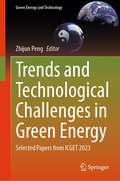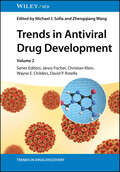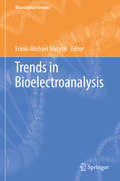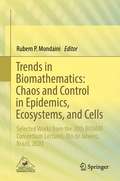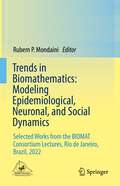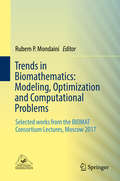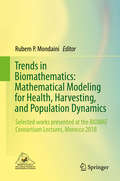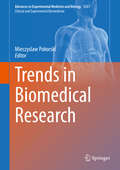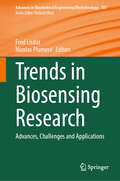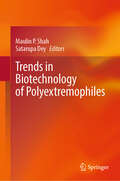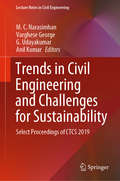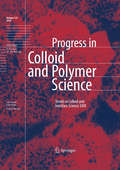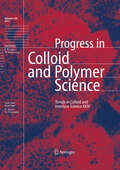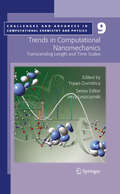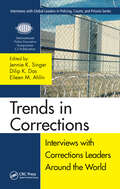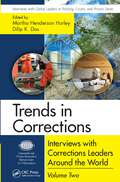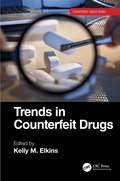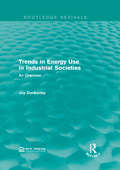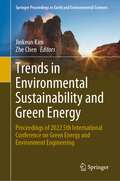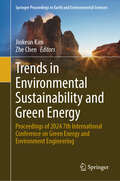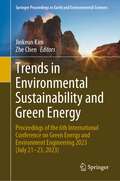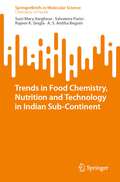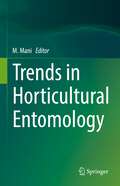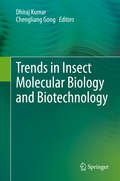- Table View
- List View
Trends and Technological Challenges in Green Energy: Selected Papers from ICGET 2023 (Green Energy and Technology)
by Zhijun PengTrends and Technological Challenges in Green Energy: Selected Papers from ICGET 2023 offers readers selected and expanded papers from the 2023 8th International Conference on Green Energy Technologies held at the University of the Applied Sciences in Hamburg, Germany. It features innovative work by academics, researchers, and industry experts highlighting the latest renewable energy developments. The book covers fundamental and practical applications for green energy resources, including security, energy consumption, localization, energy access, environment-friendly energy systems, sustainable energy development, energy-saving technologies, and conservation. It is a valuable interdisciplinary reference for young researchers, postgraduate students, professionals, and industry practitioners working with green energy technology and applications.
Trends in Antiviral Drug Development (Trends in Drug Discovery)
by David P. Rotella Wayne E. Childers János Fischer Christian KleinHard-to-find insights from industry professionals on success strategies for developing the next generation of antiviral blockbuster drugs Presented by industry professionals with a track record of discovering new drugs and treatments, Trends in Antiviral Drug Development describes successful development efforts for antiviral compounds and therapies that have entered the market or are currently in clinical trials. Viruses are ordered by their target tissue, in line with contemporary drug development that focuses on tissue-targeted therapeutics. Other key trends in antiviral therapy, such as the effort to develop long-acting drugs, are described for each virus type, enabling readers to follow the current and future state in this core area of contemporary drug development. Trends in Antiviral Drug Development includes discussion on: Novel drugs against herpes viruses as well as the breakthrough drugs that cured HCVsiRNA therapeutics, a new antiviral modality, and the drug candidates that are progressing toward achieving an HBV cureDrugs targeting viral entry, such as in HIV entry through attachment, co-receptor binding, and fusionNovel therapeutics against tropical diseases such as dengue fever and monkey pox Trends in Antiviral Drug Development is an essential read for medicinal chemists, pharmaceutical chemists, virologists, and all professionals seeking to understand new ideas and approaches to combat the ever-expanding universe of viral infections.
Trends in Bioelectroanalysis
by Frank-Michael MatysikThis volume offers a careful selection of trend-setting topics in the field. In-depth review articles illustrate current trends in the field. Experienced experts present a comprehensive overview concerning the electrochemical biosensing of glucose for diabetes care from an industrial research and development perspective a survey of bioassay applications for individually addressable electrochemical arrays, focusing on liquid-phase bioanalytical assays a review of recent advances in the development of electronic tongues based on the use of biosensor arrays coupled with advanced chemometric data analysis novel strategies of DNA biosensor development and corresponding applications for studies of DNA damage a survey of recent trends in the electrochemistry of redox proteins, including the increasing diversity of redox proteins used in electrochemical studies, novel immobilization strategies, and biosensor / biofuel cell applications an overview of electrochemical sensing of blood gases with advanced sensor concepts a survey of recent bioelectroanalytical studies with high spatial resolution using scanning electrochemical microscopy with a wide range of applications covering imaging of living cells, studies of metabolic activity, imaging of local enzyme activity, and studies of transport through biolayers This timely collection will be of interest not only for experts in the field, but also to students and their teachers in disciplines that include analytical chemistry, biology, electrochemistry, and various interdisciplinary research areas.
Trends in Biomathematics: Selected Works from the 20th BIOMAT Consortium Lectures, Rio de Janeiro, Brazil, 2020
by Rubem P. MondainiThis volume gathers together selected, peer-reviewed papers presented at the BIOMAT 2020 International Symposium, which was virtually held on November 1-6, 2020, with an organization staff based in Rio de Janeiro, Brazil. Topics covered in this volume include infection modeling, with an emphasis on different aspects of the COVID-19 and novel Coronavirus spread; a description of the effectiveness of quarantine measures via dynamic analysis of SLIR model; hemodynamic simulations in time-dependent domains; an optimal control model for the Ebola disease; and the co-existence of chaos and control in the context of biological models. Texts in agroforestry, economic development, and wastewater treatment processes complete this volume.Held every year since 2001, the BIOMAT International Symposium gathers together, in a single conference, researchers from Mathematics, Physics, Biology, and affine fields to promote the interdisciplinary exchange of results, ideas and techniques, promoting truly international cooperation for problem discussion. The 20th edition of the BIOMAT International Symposium has received contributions by authors from 18 countries: Algeria, Brazil, Cameroon, Canada, Chile, China (Hong Kong), Colombia, Germany, Hungary, India, Italy, Morocco, Nigeria, Russia, Senegal, South Africa, USA, and Uzbekistan. Previous BIOMAT volumes with selected works from 2017, 2018, and 2019 were also published by Springer.
Trends in Biomathematics: Selected Works from the BIOMAT Consortium Lectures, Rio de Janeiro, Brazil, 2022
by Rubem P. MondainiThis volume gathers together selected peer-reviewed works presented at the BIOMAT 2022 International Symposium, which was virtually held on November 7-11, 2022, with an organization staff based in Rio de Janeiro, Brazil. Topics touched on in this volume include infection spread in a population described by an agent-based approach; the study of gene essentiality via network-based computational modeling; stochastic models of neuronal dynamics; and the modeling of a statistical distribution of amino acids in protein domain families. The reader will also find texts in epidemic models with dynamic social distancing; with no vertical transmission; and with general incidence rates. Aspects of COVID-19 dynamics: the use of an SEIR model to analyze its spread in Brazil; the age-dependent manner of modeling its spread pattern; the impact of media awareness programs; and a web-based computational tool for Non-invasive hemodynamics evaluation of coronary stenosis are also covered. Held every year since 2001, The BIOMAT International Symposium gathers together, in a single conference, researchers from Mathematics, Physics, Biology, and affine fields to promote the interdisciplinary exchange of results, ideas and techniques, promoting truly international cooperation for problem discussion. BIOMAT volumes published from 2017 to 2021 are also available by Springer.
Trends in Biomathematics: Selected works from the BIOMAT Consortium Lectures, Moscow 2017
by Rubem P. MondainiThis book brings together carefully selected, peer-reviewed works on mathematical biology presented at the BIOMAT International Symposium on Mathematical and Computational Biology, which was held at the Institute of Numerical Mathematics, Russian Academy of Sciences, in October 2017, in Moscow. Topics covered include, but are not limited to, the evolution of spatial patterns on metapopulations, problems related to cardiovascular diseases and modeled by boundary control techniques in hemodynamics, algebraic modeling of the genetic code, and multi-step biochemical pathways. Also, new results are presented on topics like pattern recognition of probability distribution of amino acids, somitogenesis through reaction-diffusion models, mathematical modeling of infectious diseases, and many others. Experts, scientific practitioners, graduate students and professionals working in various interdisciplinary fields will find this book a rich resource for research and applications alike.
Trends in Biomathematics: Selected works presented at the BIOMAT Consortium Lectures, Morocco 2018
by Rubem P. MondainiThis volume offers a collection of carefully selected, peer-reviewed papers presented at the BIOMAT 2018 International Symposium, which was held at the University Hassan II, Morocco, from October 29th to November 2nd, 2018. The topics covered include applications of mathematical modeling in hepatitis B, HIV and Chikungunya infections; tumor cell dynamics; inflammatory processes; chemotherapeutic drug effects; and population dynamics. Also discussing the application of techniques like the generalized stochastic Milevsky-Promislov model, numerical simulations and convergence of discrete and continuous models, it is an invaluable resource on interdisciplinary research in mathematical biology for students, researchers, and professionals.Held every year since 2001, the BIOMAT International Symposium gathers together, in a single conference, researchers from Mathematics, Physics, Biology, and affine fields to promote the interdisciplinary exchange of results, ideas and techniques, promoting truly international cooperation for problem discussion. The 2018 edition of BIOMAT International Symposium received contributions by authors from seventeen countries: Algeria, Brazil, Cameroon, Canada, Chad, Colombia, France, Germany, Hungary, Italy, Mali, Morocco, Nigeria, Poland, Portugal, Russia, and Senegal. Selected papers presented at the 2017 edition of this Symposium were also published by Springer, in the volume “Trends in Biomathematics: Modeling, Optimization and Computational Problems” (978-3-319-91091-8).
Trends in Biomedical Research (Advances in Experimental Medicine and Biology #1251)
by Mieczyslaw PokorskiThis book addresses hot issues in the research and management of difficult-to-treat medical disorders that are commonly encountered, but for which the underlying mechanisms are often unknown.These include the adverse effects of hemodialysis and its biocompatibility in chronic kidney insufficiency, particularly related to malnutrition and inflammation, or the vulnerability of cancer patients to bacterial meningitis, the infection that remains underdiagnosed due to limited expression of symptoms. The book also covers other key topics, such as the psychological care of lung cancer patients; difficulties in the diagnosis of diffuse axonal injury in traumatic brain injury – a disorder with a poor prognosis and high mortality rate; and the virological aspects of seasonal influenza epidemic outbreaks – a perennial modern scourge. Further, it addresses recent developments in targeted drug delivery from titanium implants and a novel integrated thermal approach to rehabilitation of neurodegeneration-related disabilities. Featuring the latest interdisciplinary trends in biomedicine, this book connects research, theory and practice to help alleviate suffering caused by a variety of diseases.It is a resource for medical professionals, including academics, practitioners and all allied healthcare workers.
Trends in Biosensing Research: Advances, Challenges and Applications (Advances in Biochemical Engineering/Biotechnology #187)
by Fred Lisdat Nicolas PlumeréThis book reviews the latest developments and applications in the field of biosensing, providing readers with an update of the earlier, successful edition, Biosensing for the 21st Century. In this book, readers will find comprehensive key information on the advances and challenges in biorecognition elements and transduction principles, including examples of new materials and new methods. Ranging from engineering chimeric enzymes to the progress in electrochemical sensing of drugs, the book discusses the latest innovations in the field and thus, provides the reader with a profound overview. In the field of biological recognition the focus will be on switchable sensors by engineering new proteins, the development of Molecular Imprinted Polymers (MIPs) for proteins or even larger biological entities, the construction of complex nucleic acid – protein structures for affinity sensing and the application of whole microbes. The book covers new trends in signal transduction which includes graphene-based field effect transistors, nanopores designed for high selectivity and sensitivity in analysis, plasmonic and nanophotonic sensing applying metal nanostructures up to new developments in microarray construction. An introduction in to the challenges in skin-interfaced systems for continuous biochemical sensing, offers a glimpse into the future of wearable technologies. Furthermore, actual areas of application of new sensing strategies such as the detection of various types of viruses and bacteria or the analysis of drugs will be highlighted. Each chapter provides a scholarly yet accessible perspective on the latest trends in biosensor technology. Given its breadth, the book has an interdisciplinary appeal and engages a wide readership, from students and researchers to practitioners in academia and industry, interested in the fields of biochemical/biomedical engineering and in biosensing methodologies and applications.
Trends in Biotechnology of Polyextremophiles
by Maulin P. Shah Satarupa DeyThis book covers polyextremophiles, the latest biotechnological advances, and developments in the study of extremophilic diversity with a focus on genetics, proteomics and the impact of climate change. It sets out new perspectives on the polyextremophiles' mechanism of tolerance to extreme conditions, and it also outlines their applications in bioremediation, therapeutics, and astrobiology research. Expert contributors discuss topics such as genes associated with polyextremophiles, the applications of genome editing in extremophiles, secondary metabolites from extremophiles, and the biocatalytic potential of extemozymes isolated from extremophiles. Readers will find in this book several case studies that collate the diverse applications of polyextremophiles for bioremediation, including the use of extremophilic algae in wastewater treatment, nutrient recovery and animal feed production, the treatment of industrial waste, pharmaceuticals and personal care products, and the removal of microplastics, heavy metals and E-waste. Particular attention is given to the use of polyextremophiles for bioremediation of abandoned mining sites. The book also presents bioactive compounds from halophiles and their biomedical applications and discusses the implications of polyextremophiles in astrobiology research. Given its breadth, this book is a valuable contribution to the biotechnology of polyextremophiles by overviewing research to date and exploring challenges and opportunities for future research. It also benefits a broad readership, from scholars, researchers and students to industry professionals interested in the study and development of biotechnological applications of polyextremophiles.
Trends in Cerebrovascular Surgery and Interventions (Acta Neurochirurgica Supplement #132)
by Tetsuya Tsukahara Giuseppe Esposito Luca Regli Marco Cenzato Yasuhiko Kaku Michihiro TanakaThis is an open access proceeding book of 9th European-Japanese Cerebrovascular Congress at Milan 2018. Since many experts from Europe and Japan had very important and fruitful discussion on the management of Cerebrovascular diseases, the proceeding book is very attractive for the physician and scientists of the area.
Trends in Civil Engineering and Challenges for Sustainability: Select Proceedings of CTCS 2019 (Lecture Notes in Civil Engineering #99)
by Anil Kumar M. C. Narasimhan Varghese George G. UdayakumarThis book comprises selected papers from the International Conference on Civil Engineering Trends and Challenges for Sustainability (CTCS) 2019. The book presents latest research in several areas of civil engineering such as construction and structural engineering, geotechnical engineering, environmental engineering and sustainability, and geographical information systems. With a special emphasis on sustainable development, the book covers case studies and addresses key challenges in sustainability. The scope of the contents makes the book useful for students, researchers, and professionals interested in sustainable practices in civil engineering.
Trends in Colloid and Interface Science XXIII
by Seyda BucakThis volume includes 11 contributions to the 23rd Conference of the European Colloid and Interface Society which took in Antalya, Turkey between September 6th and 11th, 2009. The contributions from leading scientists cover a broad spectrum of topics concerning* Self Assembly* Interfacial Phenomena* Colloidal Dispersions and Colloidal Stability* Polymer Solution, Gels and Phase Behaviour* Nanostructured Materials* Biomaterials and Medical AspectsDue to the increasing significance of Colloid and Interface Science for both scientific and technical applications where scientific principles also contribute to new technologies in fast improving Nanotechnology and Medical Science, this book will be an essential source of information with respect to recent developments and results related to this field.
Trends in Colloid and Interface Science XXIV
by Karel Procházka Victor StarovThis volume includes 35 contributions to the 24th Conference of the European Colloid and Interface Society which took place in September 2010 in Prague. The contributions from leading scientists cover a broad spectrum of the following topics: * Self-assembling, Stimuli-responsive and Hierarchically Organized Systems * Colloid, Polymer and Polyelectrolyte Solutions; Concentrated Systems and Gels * Thin Films, Interfaces and Surfaces; Wetting Phenomena * Novel Nano-to-Mesostructured Functional Materials * Biologically Important and Bioinspired Systems; Pharmaceutical and Medical Applications
Trends in Computational Nanomechanics
by Traian DumitricaTrends in Computational Nanomechanics reviews recent advances in analytical and computational modeling frameworks to describe the mechanics of materials on scales ranging from the atomistic, through the microstructure or transitional, and up to the continuum. The book presents new approaches in the theory of nanosystems, recent developments in theoretical and computational methods for studying problems in which multiple length and/or time scales must be simultaneously resolved, as well as example applications in nanomechanics. This title will be a useful tool of reference for professionals, graduates and undergraduates interested in Computational Chemistry and Physics, Materials Science, Nanotechnology.
Trends in Corrections: Interviews with Corrections Leaders Around the World, Volume One (Interviews with Global Leaders in Policing, Courts, and Prisons)
by Dilip K. Das Eileen M. Ahlin Jennie K. SingerOffering rare insiders perspectives, Trends in Corrections: Interviews with Corrections Leaders Around the World is a comprehensive survey of correctional programming and management styles used across nations. Twelve chapters present transcribed interviews of corrections leaders along with a brief portrait of the corrections system in those jurisd
Trends in Corrections: Interviews with Corrections Leaders Around the World, Volume Two (Interviews with Global Leaders in Policing, Courts, and Prisons)
by Dilip K. Das Martha Henderson HurleyThe first volume of the Trends in Corrections: Interviews with Corrections Leaders Around the World series introduced readers to the great diversity that exists cross-culturally in the political, social, and economic context of the correctional system. Presenting transcribed interviews of corrections leaders, it offered a comprehensive survey of co
Trends in Counterfeit Drugs (Counterfeit Drugs Series)
by Kelly M. ElkinsCounterfeit drugs continue to infiltrate the drug market in the United States, causing illness and death. This book addresses this issue and examines the recent trends in drug counterfeiting over the past 5-10 years. The text shows perspectives from crime lab and toxicology lab personnel and academic researchers, and includes topics such as a history of cases and issues with counterfeit drugs, trends observed in forensic labs, instrumental methods and approaches used in detecting counterfeit medicines, and policy approaches for controlling counterfeit drugs. There is a focus on ways to reduce counterfeit drugs in the market, to help improve the health and safety of people all over the world. Features : Focuses on recent (5-10) year trends in counterfeit drugs and analysis. Shows perspectives from crime lab and toxicology lab personnel and academic researchers. Focuses on drugs seized by law enforcement and approaches to reducing counterfeit medicine in the market. Discusses the detection and analysis of counterfeit drugs, and appropriate tools for combating this issue. Emphasizes the global impact of illegal medicines.
Trends in Energy Use in Industrial Societies: An Overview (Routledge Revivals)
by Joy DunkerleyTaken from a report for the Electric Power Research Institute, Joy Dunkerley’s study aims to clarify the relationship between energy consumption and economic output in industrialised countries. Originally published in 1980 and using data from 1972, this study uses cross-country comparisons of energy use to stress the importance of new supply options and measures of controlling energy use without affecting living standards whilst also discussing the impact of energy prices and economic growth in the countries studied. This title will be of interest to students of environmental studies.
Trends in Environmental Sustainability and Green Energy: Proceedings of 2022 5th International Conference on Green Energy and Environment Engineering (Springer Proceedings in Earth and Environmental Sciences)
by Zhe Chen Jinkeun KimThis book consists of selected and peer-reviewed papers of 2022 5th International Conference on Green Energy and Environment Engineering (CGEEE 2022), held in Jeju Island, Korea during July 28-30, 2022. CGEEE 2022 provides a forum for researchers and practitioners in the field of green energy and environment engineering to share ideas, designs, and experiments results. Various topics are covered in this book, such as carbon capture and storage, solar energy, biomass, biofuel, geothermal, sustainable cities, energy savings for vehicular technology, solid waste management, waste minimization, water treatment and reclamation, environmental restoration, and ecological engineering. This book will be beneficial to researchers, educators, practitioners, and policymakers working in the related fields.
Trends in Environmental Sustainability and Green Energy: Proceedings of 2024 7th International Conference on Green Energy and Environment Engineering (Springer Proceedings in Earth and Environmental Sciences)
by Zhe Chen Jinkeun KimThis book comprises of selected and peer-reviewed papers presented at the 2024 7th International Conference on Green Energy and Environment Engineering (CGEEE 2024), in Seoul, South Korea during July 4-6, 2024. The conference is sponsored by University of Seoul, Korea, co-sponsored by Jeju National University, and Jeju Green Environment Centre, which aims to bring together innovative academics and industrial experts from all over the world. Topics discussed at the conference include environmental pollution and control, wastewater treatment, climate change and ecosystems management, environmental restoration, environmental regulation and monitoring, environmental systems approach, energy efficiency, energy management. These chapters provide scientists and researchers with the latest advancements in the field of green energy and environment engineering. The book will prove a useful reference to researchers, practitioners, and policy makers.
Trends in Environmental Sustainability and Green Energy: Proceedings of the 6th International Conference on Green Energy and Environment Engineering 2023 (July 21-23, 2023) (Springer Proceedings in Earth and Environmental Sciences)
by Zhe Chen Jinkeun KimThis book offers a collection of papers presented at the 2023 6th International Conference on Green Energy and Environment Engineering (CGEEE 2023), held during July 21-23, 2023 in Jeju Island, Korea. Recent studies, promising ideas and new challenges are discussed among environmental engineers, economists and social scientists, demonstrating new paradigms for problem solving and decision making. The book provides researchers and practitioners in the field of in green energy and environmental science with the latest, cutting-edge thought and research in the field. It will appeal to readers interested in these fields, especially those who are looking for new ideas and research directions.
Trends in Food Chemistry, Nutrition and Technology in Indian Sub-Continent (SpringerBriefs in Molecular Science)
by Salvatore Parisi Rajeev K. Singla Suni Mary Varghese A. S. BegumThis brief outlines the state-of-art of the food industry within the Indian Sub-continent, providing a detailed insight into the current science of nutrition and industrial technology.The Hygiene, Integrity, Traceability and Sharing (HITS) strategy has been proposed recently as a coordinated and powerful tool to contextualize the plethora of different menaces for the food consumer. The book examines this approach from eight different perspectives, with a particular emphasis on the Indian Subcontinent. Topics such as food additives, the importance of water in the food industry, the use of antioxidants, and novel food preservation methods are used to illustrate these points of view.This book is particularly appealing as a guide for graduate and undergraduate courses covering food production, food safety, and the training of teachers working in these science areas.
Trends in Horticultural Entomology
by M. ManiThis edited book highlights the latest information on the use of nanotechnology, satellite technology, and biotechnological tools in pest management. It covers the role of climate change and ecology in managing pests and also their molecular identification. Other methods that the book encompasses are organic pest management, host-plant resistance, semiochemicals, and bio-control technology. The book also covers insect pollinators which play important role for fruits in horticultural crop production. Intensive and extensive cultivation of horticultural crops lead to serious pest problem. Climatic conditions in India and elsewhere due to which new pests have emerged that causes severe damage to the horticultural crops. In response to this, researchers have developed new techniques to fight pests and their growing resistance to pesticides. This book covers the latest information on identity, biology, damage, seasonal development, and pest management of the horticultural crop pests. It serves to be an essential tool for horticultural professionals, including development officers, horticulturists, field-level extension workers, nurserymen, planters, and entomologists, and is a valuable source of reference for relevant researchers, teachers, and students in the region.
Trends in Insect Molecular Biology and Biotechnology
by Dhiraj Kumar Chengliang GongThis book provides an overview on the basics in insect molecular biology and presents the most recent developments in several fields such as insect genomics and proteomics, insect pathology and applications of insect derived compounds in modern research. The book aims to provide a common platform for the molecular entomologist to stimulate further research in insect molecular biology and biotechnology.Insects are one of the most versatile groups of the animal kingdom. Due to their large population sizes and adaptability since long they attract researchers’ interest as efficient resource for agricultural and biotechnological purposes. Several economically important insects such as Silkworms, Honey Bee, Lac and Drosophila or Termites were established as invertebrate model organisms. Starting with the era of genetic engineering, a broad range of molecular and genetic tools have been developed to study the molecular biology of these insects in detail and thus opened up a new horizon for multidisciplinary research. Nowadays, insect derived products are widely used in biomedical and biotechnology industries. The book targets researchers from both academia and industry, professors and graduate students working in molecular biology, biotechnology and entomology.
